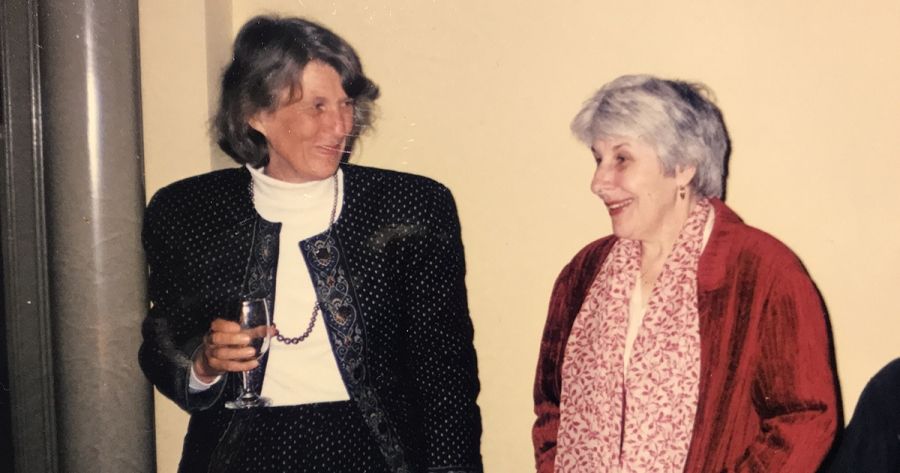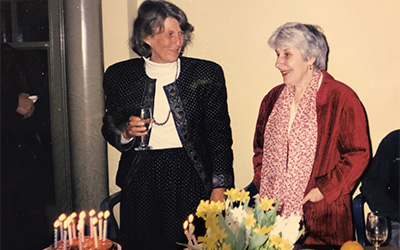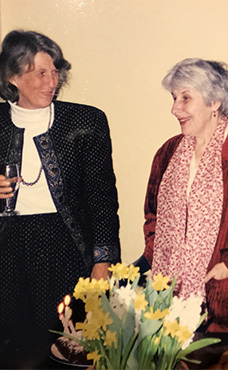
- Free Article: No
- Contents Category: Commentary
- Custom Article Title: Portrait of a friendship: In memoriam Katerina Clark (20 June 1941–1 February 2024)
- Review Article: No
- Article Title: Portrait of a friendship
- Article Subtitle: In memoriam Katerina Clark (20 June 1941–1 February 2024)
- Online Only: No
- Custom Highlight Text:
Back in the 1970s, when I went up to Katerina Clark’s place in Connecticut for the weekend, I was always a bit on my guard. Katerina was a wonderful and generous friend, but inquisitive. Being young, I had things in my personal life I wanted to hide. A silent tussle went on between us as she did her best to ferret them out (probably knowing from her other sources more or less what they were) and I stone-walled.
- Featured Image (400px * 250px):

- Alt Tag (Featured Image): ‘Portrait of a friendship: In memoriam Katerina Clark (20 June 1941–1 February 2024)’ by Sheila Fitzpatrick
Our near-simultaneous births were the beginning of the doppelgänger effect that was to continue for the next eighty years. We kept doing much the same things, but separately. Shooting across the world on similar trajectories, we often touched down in the same places, but not at the same time. It started when we both studied Russian in Nina Christesen’s department at the University of Melbourne (though I was two years ahead and did Russian only as my compulsory language). Then it was Moscow – Katerina went first, from ANU in the early 1960s, and I followed from Oxford a few years later. Katerina did her PhD in Soviet literature in the United States, while I did mine in Soviet history in the United Kingdom, but then I moved to America. (At this point, I have to start calling Katerina ‘Katy’, since this is how she was known in the United States and everywhere else except Australia, where the family’s Katerina persisted, and Russia/the Soviet Union, where she was Katya.) We both taught at the University of Texas in Austin, although our stints there overlapped by only a couple of months (to my chagrin, Katy and her husband, Michael Holquist, moved on to greener pastures in Indiana). In the 1990s, we almost ended up together at Yale, Katy and Michael’s next stop after Indiana, when I was offered a job there, but I pulled out after my husband (another Michael [Danos], known as Misha) suddenly died.
Katy was elected president of our interdisciplinary professional organisation, the American Association for the Advancement of Slavic and East European Studies in 1999; I had preceded her in this role in 1997. It was odd enough to have two Australian presidents within three years (there have never been any others, as far as I know), but even odder when you consider what we were each implicitly elected for – founding a new field that, when we started off in the 1970s, had been only marginally acceptable, but was now flourishing. Soviet literature was the field in Katy’s case, Soviet history in mine.
It was a long march to full scholarly respectability for both of us, but along different routes. This was partly because of conditions in our respective academic fields, but also because we were so unlike in temperament. Katy, much more gregarious than I in everyday life, was remarkably modest and reticent in a professional context. Her style of public presentation lacked the implicit assertion of authority that most academics develop. She moved from job to job as a ‘spousal hire’ (Holquist, her former supervisor, being the more senior); and, when her children were young, was generally employed part-time, which, as I vainly pointed out to her, only meant that she carried a full-time teaching and committee load for a half salary and less respect. Even at Yale in the 1990s, where Katy’s national and international reputation was fully made, the ‘spousal hire’ shadow took some time to dissipate.
In 1975, we were both invited, as fresh faces, to an international ‘revisionist’ conference on Stalinism organised by Princeton Professor Robert C. Tucker. Katy presented a paper foreshadowing her ground-breaking book The Soviet Novel: History as ritual (1981), but its originality was probably not recognised by the political scientists and historians in attendance. I presented a paper that, from Tucker’s point of view and that of his young associate Steve Cohen, was the wrong kind of revisionism, so there were lots of arguments and I ended up withdrawing my paper from the volume and publishing it elsewhere. That contrast in reception – Katy’s work tending to be ignored, mine to ignite acrimonious controversy – persisted to some degree for a decade or more.
My problem was basically a Cold War one. I was one of a new cohort of historians trying to write social history (history ‘from below’) in the Soviet context, which the old guard saw as ipso facto pro-Soviet, since it implied that there actually was a society to study, not just an atomised mass mobilised by commands from above. Katy’s problem was that the Russian émigrés who dominated the Slavic departments of American universities considered that true Russian literature ended with the revolution, and everything since was just propaganda – not worth reading, let alone analysing.
Katy responded to criticism with outward meekness, which made it easy to overlook the fact that, far from changing her approach, she continued doggedly to pursue it. I, on the contrary, talked back in high-visibility scholarly debates that provoked a lot of Cold War mud-slinging but also made my name. I don’t remember that Katy ever ran into any significant Cold War trouble, despite the fact that she was proposing that Soviet literature should be taken seriously, which, on the face of it, was roughly comparable to my suggestion that there was a Soviet social history to be written. In Australia, Manning’s book Meeting Soviet Man (1960) led to his being accused of being anti-Soviet, but that furore probably didn’t reach America, and anyway, Katy wasn’t yet on the US academic scene. Erupting in Australia in the late 1990s, a new round of accusations that Manning was a Soviet spy did attract international publicity; but by that time the Cold War was going out of fashion in American Sovietology. In contrast, I took considerable flack for Brian in the 1970s and 1980s, even though he was much less known in the United States than Manning was (according to malicious Sovietological rumour, he was a communist whose KGB connections had got me into the Soviet archives).
Katy liked my father, and I liked hers. I remember a delightful walk in New Haven with Manning declaiming Thomas Hardy’s poems of lost love (Katy was not present, probably in the kitchen with Dymphna, preparing dinner). Katy’s memories of Brian went back further, to the occasional visits of the Fitzpatrick family to the Clarks in Canberra when we were adolescents. I have only blurry memories of these visits myself; they focus mainly on Manning’s habit of escaping a noisy household by disappearing up the ladder to his attic study (pulling the ladder up behind him, in my memory, though that may be embellishment). What Katy remembered, and often repeated to me in later life, was: ‘Brian was so proud of you.’ To this she usually added: ‘You were very lucky.’ She saw my father’s pride and encouragement as the source of my intellectual self-confidence. I am sure that Brian boasted to the Clarks about my scholarly and musical accomplishments: he did it everywhere, to my embarrassment as a teenager. I think Manning took me more or less at Brian’s valuation. Music was always a way to Manning’s heart (my brother David, too young to be a real presence in the 1950s visits, later formed an almost filial connection with Manning on that basis), although I don’t think any of the young Clarks, certainly not Katerina, were encouraged to learn an instrument. A quiet presence, second child and only girl in a family of six, Katerina scarcely figures in my memory of these family visits. Neither Manning nor Dymphna boasted about her.
Brian died in 1965, long before Manning (1991), Dymphna (2000), and Doff (2001), which more or less equalised Katy and me in the parental approval stakes, since my mother was also a non-encourager. Doff made a late about-turn to parental pride in the 1990s, but Katy listened to my accounts of this rather glumly. The positive feelings Katy and I had for each other’s fathers probably did not extend to each other’s mothers, although we never discussed this. Katy, I would guess, took over Dymphna’s somewhat dismissive view of Doff, whose diffidence and self-consciousness could be mistaken for humility.
Katy’s first monograph, The Soviet Novel: History as ritual, a pioneering study of the ‘master plot’ of Soviet socialist realism, appeared in 1981, when it was still very much an outlier in a field focused on the refined products of late Imperial Russia’s Silver Age. But the balance was already starting to shift in American university Slavic departments, largely the result of generational change, As the émigrés grew older, more and more young people interested in working on Soviet literature entered the field. Katy’s Soviet Novel – reprinted in 1985, and then, most unusually for a dissertation book, issued in a new edition in 2000 – became a foundational text. Its appeal was not only to young literature scholars but also to young historians and anthropologists of the Soviet Union. For my graduate students at the University of Chicago in the 1990s and 2000s, it was a must-read classic, not so much because I told them to read it but because their peers did. In an odd twist to our intersecting story, Katy’s stepson, Peter Holquist, became leader of a competing group of Russian history graduate students at Columbia University, rallying under the banner of cultural history to challenge the prevailing orthodoxy in Soviet history, which for them (how short is academic memory!) was my kind of social history. Peter’s Columbia group fought pitched verbal battles with my PhD students at Chicago, but all of them read Katy’s Soviet Novel.
By this time, Katy and I had settled into a close, quasi-familial friendship mainly conducted in long monthly telephone calls, with occasional visits. When I say ‘quasi-familial’, I mean that Katy became something like family for me, not the other way round (with so many Clarks, and their strong sense of collective family identity, Katy had no need to look elsewhere). It was Katy who flew in to lend support when Misha died in 1999; and Katy who, when I found myself short of the two family members required for my induction into the American Academy of Arts and Sciences in 2005, volunteered to fill the gap. We came across more like sisters than friends, according to one American colleague, who noted that we finished each other’s sentences (a polite way of saying that we interrupted each other). Katy and I started celebrating our milestone birthdays together at the age of sixty-five, when we were in Melbourne together for a week of conferences that was also, courtesy of the Mellon Foundation, a kind of celebration of our doppelgänger careers: a day on Soviet literature for Katy, a couple of days on Soviet history for me and my Chicago graduate students, a day on Brian and Manning as Australian historians, a belated memorial evening on Brian’s centenary, and, to top it off, excerpts from Manning Clark: The Musical, performed by my cousin Peter Fitzpatrick and his singers from Monash University.
All her life in America, Katy, unlike me, was homesick for Australia. Ironically, I was the one who, in 2012, returned. We still talked on the phone every couple of weeks; I still went up to New Haven for the weekend whenever I was in New York, which was now once a year, instead of maybe twice; but in addition, on Katy’s regular visits to Australia, we started driving together from Sydney to the Clark family house in Wapengo, Dymphna’s creation, to which Katy was passionately attached. It was around this time that I became fully aware of the uniqueness of Katy’s status in my life, and I suppose mine in hers: nobody else knew all the bits – Australian, American, Soviet/Russian – and had been around since the beginning. In our phone calls, we exchanged professional gossip and family news (Katy knew the names, places of residence, and occupations of all my relatives, and would ask about them individually if I left anyone out), and talked about whatever was on our minds in non-academic life, which in my case after Misha’s death usually meant playing chamber music. Whenever she was staying with me in Chicago, and later in Sydney, Katy would quietly sit in on my string quartet sessions (nobody else did that) and quiz me about the other participants afterwards (she got to know their names, too.)
An odd thing was that we did not usually talk substantively about our work, or at least my work, even though our areas of expertise were quite close. I read Katy’s books, and I suppose she must have read mine, both the scholarly ones and the memoirs (how not, given all the personal information there), but she virtually never commented on them to me. I think it was a bit of a sore spot with Katy that I wrote faster than she did and published more books. On the issue of social versus cultural history, I assumed that, as a loving and beloved stepmother, as well as a literary scholar cum cultural historian herself, she was with Peter on the cultural side. (Actually, I was at least half on the cultural side myself, but I’m not sure that Katy acknowledged that.) She knew the names and dissertation topics of most of my old Chicago students, and used to ask about them, but this was one area of conversation where I still watched what I said – I had my own competing loyalties.
Throughout 2023, during her illness, we were doing weekly Zooms, but no video, a condition of hers. Our conversations changed somewhat in this last year. Isolated by the illness, Katy was reading a lot of background on the Ukraine and Gaza wars, and she talked about these issues with such confidence and authority that I could suddenly imagine her, for the first time, as a public intellectual. She was also much readier than in the past to talk in detail about her current work (a book on the very interesting Soviet Kyrgyz writer Chinghiz Aitmatov; she managed to finish a first draft). I saw Katy for the last time in New Haven at the end of November 2023. The ‘no video’ rule made me expect to find her greatly changed, at least physically, but she was entirely herself, quite undiminished. Since she was immune-suppressed and not really supposed to see people, we had to sit at opposite ends of a long table, à la Putin, but then we went for a long walk, the way we always did. Mid-walk, under idyllic blue skies, two tall godlike figures on bicycles swooped down on us with cries of affectionate greeting: her devoted neighbours, one of whom – always these interconnections! – I had known slightly in Texas. Katy was radiant, and we all radiated back, a moment of love. Like an idiot, but also because I knew she didn’t like being photographed, I didn’t take a photo. These last images of her exist only, but very vividly, in my mind.
When I heard of my father’s death in 1965, the first reaction was a kind of childish panic: what next, once the audience for the performance of my life has abruptly left the theatre? Katy wasn’t my audience in that sense (after all, I’m not twenty-four anymore). But she was the audience in the more comfortable, everyday sense that is at the heart of friendship. When something happened, I thought: ‘I must remember to tell Katy.’ She was the person to whom I regularly recounted the events of my life, trivial or otherwise, since our last conversation; the one who knew all the names, didn’t need to have anything explained, and remembered what she was told – a kind of recording angel with no looming Day of Judgement. Thinking back to the 1970s, I have to apologise to Katy for holding out on her, as she tried to gather all the information necessary for her task. By the 2020s, I was telling her everything; and I wasn’t the only one: Katy/Katerina was a person with a gift for friendship. Who is there to keep up the records on us now?



Comments powered by CComment